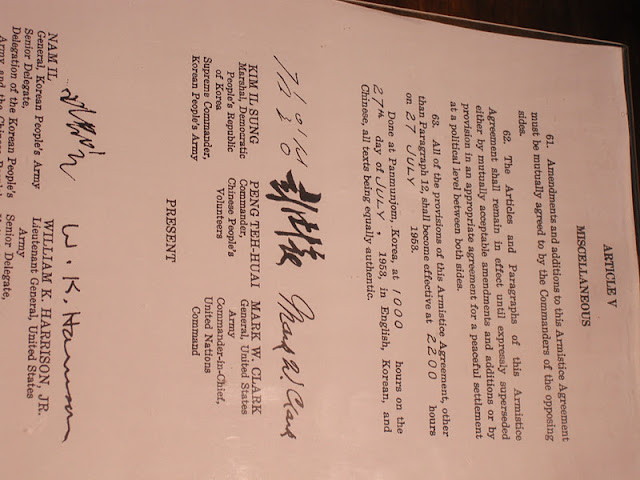for the last year and 4 months we have been living in a country that is still at war, although this war has had little to no effect on our everyday life of walking the streets, going to work from 9-5, making dinner, going out on the town dancing, attending church, playing at the park, etc., but when we finally were able to attend the DMZ tour, we realized that this war had a huge effect on these everyday activities only about 50 years ago.
the DMZ is a strip of land that runs across the korean peninsula at the 38th parallel. it is a dividing line between north and south korea and acts as a buffer zone. it was created at the time that both north and south korea decided to put their active battle on halt and pull their troops out of each side.
now the DMZ is heavily guarded on both sides. on our tour we were able to approach the north korean line. we stood about 100 yards away from north korean soldiers. our US military tour guide warned us that we should keep our hands in our pockets because if we make any sudden movements, point or make any hand motions, north korea may shoot us.
below is a picture of a south korean soldiers facing the north korean side. you can see a dividing line that runs between the blue buildings. south korean soldiers hide half of their bodies behind the building so that they become a more difficult target to shoot. they stand in that position without moving for hours. they wear sunglasses to hide any emotions in their eyes and they hold their fists tight by their side in a judo combat position so that they are ready to act at any time.
we went into the blue building where north and south koreans hold meetings with each other. we all slowly walked over the dividing line in the building to take a picture with a south korean guard. now we can say that we went to north korea.
south korea has a small town on their side of the DMZ inhabited by people who were there before the war began. when both sides created the DMZ, north korea decided that they wanted a town on their side of the DMZ, but north korea's town is a fake. the buildings don't have floors and most of the doors are painted on. they tried to make the outsides of all the buildings look nice to entice the south koreans to jump the border and come to north korea. in their fake town they built a giant flagpole to be larger than the one on south korea's side. they also used to blast propoganda so that the people in the south korean town could hear.
when they first created the DMZ, both sides' troops could move freely within it until north korea attacked a group of south koreans and americans who were trying to cut down a tree to give themselves a better view of their sentry post. it is called the axe murder incident. three people were killed.
next to the area where the axe murder incident occurred is a bridge called 'the bridge of no return.' when the armistice was signed by both sides, each side brought their prisoners of war to this bridge. the prisoners were given a choice to stay on the side they were on or cross over. if they crossed over, they were no longer welcome to ever come back, hence the name.
this is a picture next to the tunnel we were able to walk in. north korea had built 4 tunnels under the DMZ that were found by south korea between the 50's and 70's. the tunnels were built for an eventual surprise attack on seoul, but south korea found the tunnels and blocked them before north korea had a chance to use them.
we went to a train station that south korea hopes will one day be running into north korea once the war is over. we saw more guards and wanted to take a picture with them, so my friend kara said, "kimchi jeuseyo," which means, "give me kimchi." the guards knew what she was trying to say and responded in English with "yes, you can take a picture with us."
kimchi is what koreans say when they take a picture, just like we say the word "cheese" when we take pictures. so imagine a foreigner walking up to a person in the states and saying, "give me cheese."
they also had stamps from the train station, kinda cool if you wanted a memory of being on the tour and at the last train stop before you get to north korea. we didn't have any paper to stamp so we stamped our wrists.











No comments:
Post a Comment